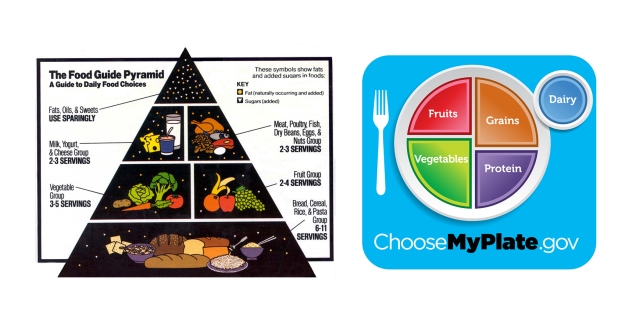When the United States Department of Agriculture replaced the traditional Food Pyramid with MyPlate in 2011, the vague serving suggestions were replaced with an easier-to-understand graphic – a colorful plate divided into visual percentages.
To help reeducate people about the new guidelines, we’re highlighting the differences from the Food Pyramid to MyPlate throughout the month. This week it’s all about protein.
The nutrients in protein-rich foods are important to eat at each meal. Loaded with Vitamin B, Vitamin E, iron, zinc and magnesium, high protein foods help build muscle and bone, red blood cells and iron.
In the Food Pyramid, vital proteins were represented by a variety of types – meat, poultry, fish, beans, eggs and nuts – and suggested 2-3 servings. However, it didn’t clarify what a serving size was, the difference in each type of protein nor how they should be prepared. That’s changed to make it more practical and understandable.
Now, the lower right wedge of MyPlate – symbolized in purple – is devoted to protein, which should be approximately 20% of each meal. It still represents the same types of protein as before, but now elaborates on serving sizes, preparation and vegetarian choices.
For example, women 31 and older should eat 5 ounces of protein at each meal, while men can eat 6 ounces if they’re 31-50 and 5 ½ ounces if they’re 51 or older. These recommendations are based on those who get 30 minutes or less of moderate physical activity, beyond normal daily activities. But ounce-equivalents are not always easy to know if you aren’t weighing everything. Here are some specific suggestions based on different protein groups:
Beef – 1 small steak or filet
Poultry – 1 small chicken breast
Seafood – 1 can of tuna
Eggs – 4 eggs
Nuts – 4 tablespoons of peanut butter
Beans – 1 cup of cooked beans or peas
Make sure to include a variety of these different proteins throughout the week. Try to include a protein source that’s rich in omega-3 fatty acids such as wild salmon or trout. Also, choose lean meats – whether you’re preparing poultry, beef or pork. It’s important to choose protein sources that will give you the nutrients, but not the fat – especially saturated fats.
Saturated fats increase low-density lipoprotein – more commonly referred to as LDL or ‘bad’ cholesterol. These generally occur in foods from animals – beef, pork and lamb, and egg yolks, as well prepared meats such as sausage, bacon and lunchmeats.
If the meat is already ground, try to choose between 90-95% lean and remove the skin from poultry before cooking. Proteins that are high in saturated fats are also higher in calories, so be mindful of that when choosing meats.
Even though you don’t have to commit to being a vegetarian or vegan, try including one of those meals at least once per week. Swap out ground beef for a veggie burger or prepare bean burritos instead of ones with meat. You can also add toasted cashews to a stir-fry instead of meat or walnuts to a salad instead of cheese. Try experimenting with delicious tofu or tempeh as a substitute for meat.
When choosing protein sources, read the food label to see how much sodium was used – especially in the case of ham, sandwich meats and self-basted poultry. Often those are very high in sodium and can push you past the suggested limit of 2,400 mg per day in just one serving.
It also matters how you prepare the protein source. Before cooking, trim away all visible fat, skip the breading and drain any fat that appears during cooking. Instead of frying in oil or butter, try broiling, grilling, roasting or poaching. Besides having less fat, you’ll also enjoy the natural flavors.
Just trying a few of these suggestions will give you all the protein you need, but in more nutritious ways. You’ll be building a stronger body, while reducing high amounts of fat and sodium generally associated with protein-rich foods.
Remember – Nuts help reduce the risk of heart disease, but they are also very high in calories. Eat small portions in place of meat and make sure they are unsalted.
Sources:
http://www.disabled-world.com/artman/publish/food_pyramid.shtml
http://www.nursingdegree.net/blog/746/10-most-pervasive-food-pyramid-myths/
Related Articles
Replacing the Food Pyramid With MyPlate

Join the Discussion
0 Comments